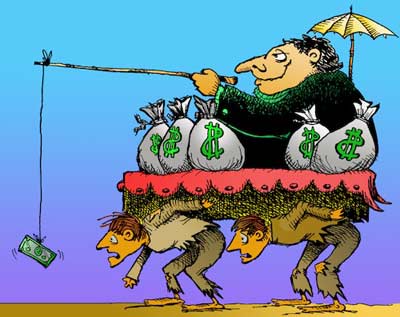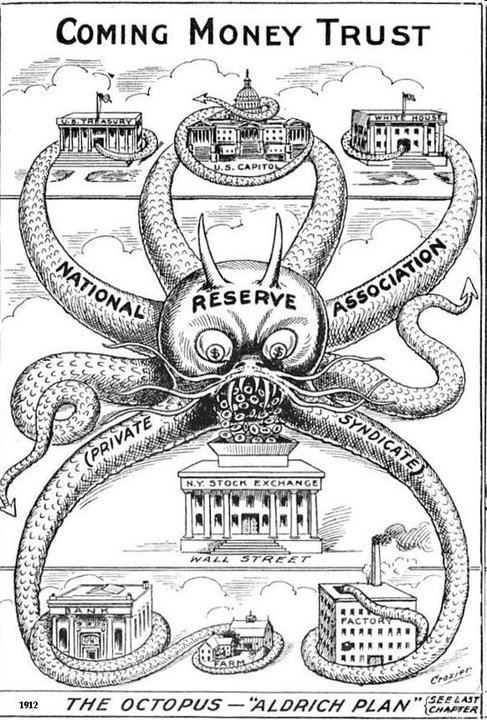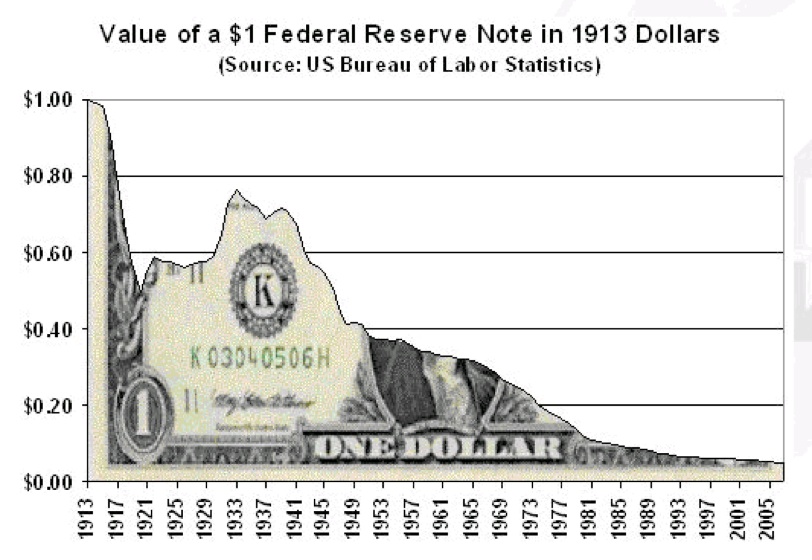
When I wrote about Mercantilism last week I mentioned merchant princes and bankers. I neglected to mention transport. You can not have trade without transporting trade goods from one place to another. If you look at American Indians, they had trade routes and used humans, canoes, dogs & camelids for transport. In Eurasia they were lucky enough to have donkeys, camels, horses, oxen and even elephants as beasts of burden. On top of that was the use of the wheel. However the favorite method was by water, to the point rivers were modified and canals were built. Even today water is a preferred method of transporting large amount of goods. And the corollary is you need SAFE trade routes.
Going back in time, to the Khazars and before, you have the Silk Road–a network of trade routes.
THE SILK ROAD

The History of the Silk Road Trade and Cultural Exchange:
BY Umair Waseem [He seems to have other interesting articles.]
The Silk Road was a network of trade routes that connected the East and the West. It spanned across Asia, reaching parts of Europe and Africa. Over the centuries, it played a vital role in the exchange of goods, ideas, and culture. This historic route was not just about commerce; it was also about bridging distant cultures.
The history of the Silk Road traces back to the Han Dynasty of China around 130 BCE. The route started as an overland and maritime network. It connected the great cities of China to Central Asia, the Middle East, and Europe. The earliest motivation was the need for silk.
The term “Silk Road” was coined by the German geographer Ferdinand von Richthofen in the 19th century. The term actually refers to the trade of silk, which was one of the most valuable goods traded along the route. However, many other products, such as spices, precious metals, and textiles, were also exchanged.
Key Trade Routes and Expansion:
The Silk Road was not a single road but a network of routes that connected regions….
The Role of Empires in the Silk Road:
There were a number of great powers that helped in the establishment and defense of the Silk Road. The first of these was the Han Dynasty of China, which established strong trade ties with Central Asia. This enabled the empire to dominate the eastern part of the Silk Road and ensure safe passage for goods and people.
The Roman Empire also played a crucial role in the trade along the Silk Road. Even though the Romans never managed to dominate the entire route, their demand for luxury goods such as silk helped propel the trade. The Persian Empire served as an intermediary between East and West, facilitating trade and communication.
The Mongol Empire, under Genghis Khan and his successors, revived the Silk Road. They provided protection and stabilization along the routes, which became a hotbed for merchants to once again trade as they wanted….
Decline of the Silk Road:
…👉the Silk Road began its decline by the 15th century.👈 The reasons why this occurred were several: the rise of the Ottoman Empire in the 14th century… 👉Ottomans controlled much of the Silk Road in key parts that made it arduous for Europeans to access Asian markets.👈
….the discovery of the maritime trade route made it the efficient way to go. Maritime explorers began to explore sea routes to Asia bypassing the Silk Road totally as it had become an overland road. This led to a decline in trade patterned along the Silk Road accompanied by political instability and attacks….
So the Silk Road trade routes were very important to various empires in the Old World and ESPECIALLY to the people who made money off of trade, that is the bankers and the Merchant Princes. I am going to leave the British East India Company and its tie-ins to another article.
The Brits, as a naval power, were very, very interested in the Middle East. They were also interested in an overland route thru the Middle East.
Treaty of Çanak, (Jan. 5, 1809), pact signed between the Ottoman Empire and Great Britain at Çanak (now Çanakkale, Turkey)
…the Treaty of Çanak offered security to the British against the entry of the Russian fleet from the Black Sea into the Mediterranean. It also reaffirmed in full Great Britain’s capitulary rights (trading and consular privileges) in the Ottoman Empire, while its secret provisions provided that the British assist the Ottomans in the event of a French declaration of war against them.
(PDF) the 1838 Anglo/Ottoman Commercial Treaty
This agreement expanding British trade rights in Ottoman Empire.
ENTER THE FRENCH

The British and the Ottoman Middle East, 1798-c.1850
In 1798, Napoleon Bonaparte invaded Egypt. This was intended to be a blow against the fast-expanding British Empire in India and a major extension into Asia of the war for global dominance between the British and French. Napoleon’s move highlighted to the British the importance of the region between the Mediterranean and India and particularly the large part of it ruled by the Ottoman Empire. In the next fifty years the British became preoccupied with strengthening their position in these lands by using their sea power in the Mediterranean, Indian Ocean and Persian Gulf to frustrate their French and also increasingly their Russian rivals. This Special Subject [Course] tells the story of British activities in, attitudes to, and experiences of the Ottoman Middle East in this period, particularly in relation to Egypt, Syria, Arabia and Baghdad. 👉The British could not seize these territories because their international strategy depended on trying to keep the Ottoman Empire alive,👈 but most observers believed that it would shortly collapse and that it was essential to ensure political, economic 👉and moral influence in advance of that point.👈 The course’s ultimate objective is to trace the connections between political, cultural and religious activities in these territories: territories which were not just of strategic, diplomatic and naval significance but also of enormous interest to travellers seeking an understanding of classical and biblical history – and indeed adventure and exotic ‘Oriental’ experiences….
…a great discussion about British political and economic interests, leading among other things to the 1838 Anglo-Ottoman trade treaty (week 5); the invasion of Syria and Palestine in 1840-1 by British troops and agents, 👉resulting in the protection of designated religious minorities👈…
OK, I want to stop here and look at what the Rothschilds were doing in the 1800s during this time period since they funded most of the European countries and their wars.
Do not forget one of the Rothschilds was a French Banker. The Bank of France was established in 1800. However Napoleon never trusted the Bank of France and he believed that France had to break free of debt. “..The Bank of England was quick to oppose him. By financing every nation in his path, they reaped enormous profits from the war. (Warning bells should be sounding for those of you drawing correlations between that and the international actions of the U.S. since World War II). Profit From War. Prussia, Austria and Russia all fell heavily into debt in their attempts to stop Napoleon….”
Nathan Rothschild funded the Napoleonic Wars.
…Nathan knew Napoleon had lost the Battle of Waterloo before the English monarchy. With this information in hand, Nathan spread the rumor that Napoleon had won and that everyone on the English Stock Market should start selling their useless English money. Rothchilds’ agents were then able to purchase nearly the entire English Stock Market at incredibly low prices, thus controlling the entire English market before everyone found out that England, in reality, had beaten Napoleon.
👉As of 2015, the English government is still paying back money owed to the Rothschild family from this Napoleonic fraud…👈
That article has since been re-written and updated as of Aug, 1 2024. All mention of the English government owing the Rothschilds money is gone. The current author is Jennifer L. Cook who got her start in editorial work in London as a researcher for three industrial relations journals. Her Education: University of California at Santa Cruz.
A QUICK TIMELINE
Also see: Timeline – European 19th – Early 20th Century Middle East Intervention and Middle East Uprisings
1858 — The Suez Canal was an immensely profitable investment by the Rothschild family. The family basically owned the British banking system and had funded all the British war efforts throughout the 19th century. Because the Suez Canal was built with slave labor, the Brits did not want their name associated with the building of it. Prime Minister, Benjamin Disraeli, (Jewish BTW) had N M Rothschild & Sons act for the British Government instead. Disraeli was a close personal friend of Lionel de Rothschild. LINK
1881 – Assassination of Tsar Alexander II in retaliation for his help during the US Civil War. It was also the start of the Jewish Pogram in Russia in retaliation for the Jewish Socialists murdering the Tsar.
1882 -1918 — The Rothschilds began to buy land in Palestine. The Rothschilds had international power as they lent money to all governments. By 1918, one-twentieth of Palestine’s fertile lands belonged to the Rothschilds. — Who sold Palestine?
Remember these Jews were refugees because Jewish Socialists, financed by the Rothschilds, had assassinated the Tzar and Russians took out their anger on the entire Jewish community. Also, exactly WHO owns Israel NOW if the Rothschilds bought the land?
1895 — London School of Economics was founded by Sidney Webb. Among its major contributors: the Rockefeller Foundation, the Carnegie United Kingdom Trust, and Mrs. Ernest Elmhirst, the widow of J. P. Morgan partner Willard Straight, who founded the socialist magazine New Republic. — The Fabians, the Round Table, and the Rhodes Scholars
The Fabian co-founders, the Webbs, founded the London School of economics with a bit of financial help from Nathan Rothschild. [ALL references are now gone…]
More recently Evelyn de Rothschild was a governor of LSU.
The Rothschild Family: An Evil Dynasty Poised to Rule the World, Or Just Simply a Banking Powerhouse?
Although the following article is an ‘approved’ viewpoint, it has a few very interesting bits. Today I am looking at the Middle East connections.
Their Influence on European Industrialisation
Given their geographical banking control and massive wealth throughout the 19th century, the Rothschild family pioneered international high finance during the industrialisation of Europe and were instrumental in supporting railway systems across the world and 👉in complex government financing for projects such as the Suez Canal. The Suez Canal was another immensely profitable investment by the Rothschild family…👈
British recognized the canal as an important trade route, they objected to the use of forced Egyptian labour to build it, and perceived the French project as a threat to their geopolitical and financial interests.
So, over a span of eleven years, starting on December 15th, 1858 the Suez canal was built. The Rothschild’s basically owned the British banking system at the time since they funded all prior British war efforts throughout the 19th century. Thus, In 1875, the London banking house of N M Rothschild & Sons advanced the Prime Minister, Benjamin Disraeli. They effectively acted for the British Government, and paid a sum of £4,000,000 to purchase Suez Canal shares. Disraeli was a close personal friend of Lionel de Rothschild, and according to legend, this was transacted on a gentleman’s agreement, with no documentation, a technically unsecured loan for a sum of over £550 million today.
Basically, England recognized the huge economical gain of purchasing shares in this trans-continental shipping route, but they did not want to be recognized for supporting the forced labour (slavery) that was implemented in order to build the canal….

Napoleon invades Egypt
The Suez Canal was primarily built by France, with Ferdinand de Lesseps, a French diplomat, playing a key role in obtaining the political and financial support. Construction began on April 25, 1859, and the canal was completed and officially opened on November 17, 1869. With the US cotton coming back on the market after the Civil War, the price of Egyptian cotton fell allowing the Rothschilds to move in and take the Egyptian shares. (I lost that link)
The map below illustrates just how critical control of the Suez Canal is. As I go deeper into this please keep that map in the back of your mind.

The Suez Canal Crisis of 1956 & The Rise of the US
In 1956, the president of Egypt, Gamal Abdel Nasser, nationalized the Suez Canal, which had mostly been owned by British and French investors. This canal was a major part of ocean-going shipping and allowed ships to pass into the Mediterranean from the Red Sea, effectively linking Europe to the Indian Ocean and trade from Asia. Swiftly, Israel, Britain, and France moved to intervene and invaded Egypt. Against the background of the Cold War and the anti-colonialism movement, the aggressive actions by Israel, Britain, and France heightened tensions with the Soviet-backed Arab states in the Middle East….
In 1798, a French general named Napoleon Bonaparte invaded Egypt, which was then part of the Ottoman Empire, with some 30,000 troops. Napoleon’s successful invasion and seizure of Cairo, the capital city, was quickly noticed by the British. With Napoleon’s massive army helpless on land, the British destroyed the French fleet in the Mediterranean. Moving by land, France faced another crippling blow when the British allied with the Ottomans to thwart Napoleon’s plans to take Syria. After just over a year in Egypt, Napoleon returned home to France, where he began seizing power as a dictator.
British interest in Egypt began in the 1860s due to two events: the US Civil War (1861-65) reducing the amount of cotton exported to Britain from the American South, and the completion of the Suez Canal in 1869. Swiftly, Egypt moved to increase cotton production, which would be bound for the textile mills of England.
👉The Suez Canal also benefited the British, as ships could now pass through the Mediterranean to reach India. At this time, India was Britain’s most valuable colony.👈 This began a political tug-of-war between Britain and France regarding which European power would “control” Egypt…..
Between the 1880s and World War I, Britain came to dominate more and more of Egypt’s affairs. Officially, Egypt was under the control of the Ottoman Empire, and the outbreak of hostilities between the Allied Powers (which included Britain) and the Central Powers (which included the Ottoman Empire) allowed Britain to seize control of Egypt. This year, 1914, saw Britain seize the Suez Canal and declare Egypt a protectorate. After World War I, Egyptians began fighting for independence, which was granted in 1922. However, British troops remained in Egypt until 1929, when they withdrew. The Suez Canal zone, similar to the Panama Canal zone in Central America, remained under British military control….
July 1956: Egypt Nationalizes the Suez Canal
In July 1952, a coup overthrew king Faruk I of Egypt, and one of the main plotters was a young man named Gamal Abdel Nasser. Three years later, Nasser was Egypt’s undisputed leader and positioned his country as one of the leading nonaligned states, meaning it was neither a formal ally of the United States nor the Soviet Union. However, Nasser was not a true Marxist and focused more on Arab nationalism and decolonization than socialism. On July 26, 1956, he announced the nationalization of the Suez Canal. This violated a 1954 agreement that said the Suez Canal Company would not be transferred to Egyptian control before 1968.

On October 29, 1956, Israel began its invasion of Egypt on the Sinai Peninsula and defeated opposing Egyptian forces. The Israelis advanced toward the Suez Canal from the west using ground forces. This conflict between Israel and Egypt was not shocking, as Egypt had been one of the several Arab states to fight against Israel in the Arab-Israeli War of 1948. The United Nation’s creation of a new Jewish territory in November 1947, using the land of British Palestine, was seen as an encroachment on Arab sovereignty. In May 1948, just as the new nation of Israel declared its independence, war broke out between it and neighboring Arab states.
Israel won its war for independence, but intense hostility lingered. Egypt prevented Israel from using the Suez Canal, motivating Israel to wrest the canal from Egyptian control. As Israeli forces pushed toward the canal in autumn of 1956, a trap was sprung by Britain and France against the Egyptians. Having plotted ahead of time with the Israelis, Britain and France called for a cease-fire by both sides in the growing war. When Nasser rejected this cease-fire, as was anticipated, Britain and France had an excuse to engage militarily….
Remember the Brits had ALSO promised the SAME LAND to the Arabs as to the Jews in return for revolting against the Ottoman Empire.
THE BRITISH PROMISED THE ARABS THIS
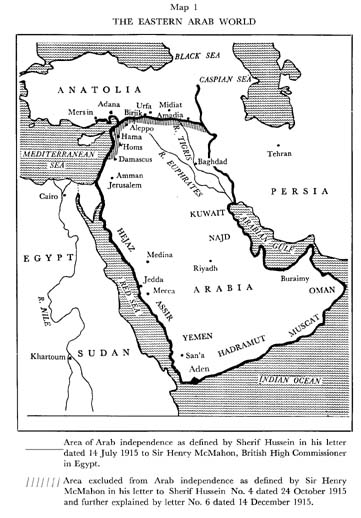
THE REAL BRITISH PLANS
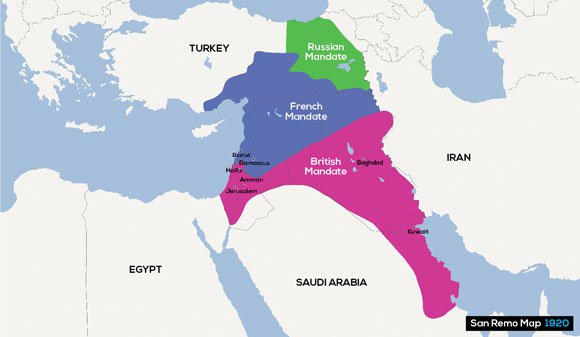
WHAT ACTUALLY HAPPENED
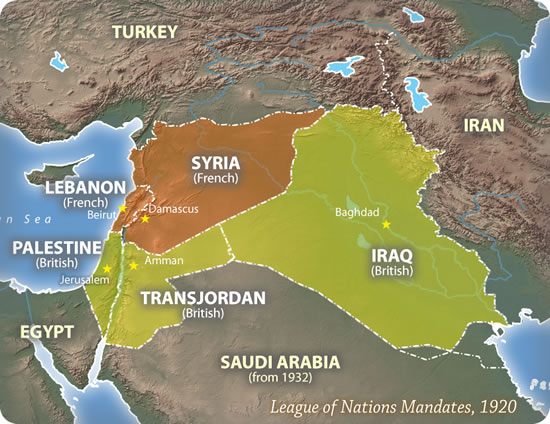
Back in 1915, the British needed the help of the Arabs in defeating the Ottoman Empire in World War I. In a set of letters called the ‘McMahon–Hussein Correspondence,’ they promised the Arabs that if they rebelled against The Ottoman Empire (which had sided with Germany in the war), that they would get their own independent state (as depicted in the first map above). However, at the very same time the British made this promise, there was clandestine agreement in the works with France and Russia to carve up the Ottoman Empire amongst themselves. This was known as the ‘Sykes-Picot Agreement.’ Suffice it to say, the territory promised to the Arabs was not a part of their bargain. Then to make matters even more confusing, there was a third – and completely separate agreement with the Zionist community called the ‘Balfour Declaration’, promising the Jews their own ethno-state within the borders of Palestine.
So with these three contradictory agreements all made at the same time, it was clear that somebody was going to get deceived. In the end, the British promises to the Arabs were a fraud.
The Arabs fought and died for the British, thinking that they would gain their independence as a reward for their sacrifice. Yet what ended up happening instead, is that the British and French marched into their territory and claimed the remains of empire for themselves.
And we wonder why there is a festering hatred for non-Muslims in the Middle East?
Also of interest is Arthur Balfour of the Balfour-Declaration that promised a Jewish homeland in the Middle East.
[Balfour]…..who was president of the Society for Psychical Research [Linked to the Fabians.– GC] (AC Doyle, William Gladstone) from 1893 and PM of the UK from 1902 to 1905. He was a nephew of Robert Cecil. He was educated at Eton College (under William Johnson, accused of pedophilia) and Trinity College Cambridge like Cecil agent Aleister Crowley… He was a member of the Royal Society and Eugenics Education Society with Oddfellow Winston Churchill, Margaret Sanger, Cyril Burt, Hans Eynsenck (student of Burt), Madison Grant, John Harvey Kellogg, Roger Pearson (Order of Malta), John Maynard Keynes, Frederick Osborn (APS, Pioneer Fund), William Beveride (British Welfare State of the Fabians), Havelock Ellis and Julian Huxley (founder of WWF) as president.
>>>>>>>>>>>>>>>>>>>>>>>>>>
I think at this point you can see why the Brits had a vested interest in trade routes through the middle east. AND that they were willing to fight to get control of those routes. Given India has played a central role in this drama, I am going to use an article by Frontier India News Network
All you should know about the Israeli Ben Gurion Canal project
The Israelis are promoting a Red Sea-Mediterranean Sea waterway, the Ben Gurion Canal, as a rival to the Suez Canal. As per the Israelis, the distance between Eilat, a southern Israeli port and resort town on the Red Sea near Jordan, and the Mediterranean is not long and is in fact similar to the distance of the Suez connection between the Red Sea and the Mediterranean.
Although it poses a direct threat to Egypt’s Suez Canal but Suez Canal is shorter than the Israeli route and the Suez Canal rarely reaches 100 meters in height making it a better option. At the same time, Israel says this route is good for the ships which are unable to transit the Suez Canal due to restrictions on the size of the ship.
History of Canal proposals via Israel
👉In the mid-1800, the British considered the proposal of a canal to the Red Sea via the Dead Sea. In 1855, Rear Admiral William Allen FRS, an English naval officer and an explorer proposed an alternative to the Suez Canal titled “The Dead Sea – A new route to India.”👈 But William Allen did not know that the dead Sea was much below sea level. His idea was that a canal that would connect the three water bodies, Red Sea, Dead Sea and the Mediterranean Sea, would be cheaper than the projected Suez Canal. The US toyed with the idea of digging a canal opposite the Suez Canal in 1963. It was recommended in a memo submitted by Lawrence Livermore Patriot Laps in the US as a response to the decision taken by the Egyptian President Gamal Abdel Nasser to nationalize the Suez Canal in 1956. The controversial plan was revealed to the world only in 1994. The controversial US proposal involved 520 nuclear blasts to excavate more than 160 odd miles through Israel’s Negev desert, instead of traditional methods. The contentious proposal also noted that the project will be aggressively opposed by the Arab states. The canal would connect the Mediterranean Sea with the Gulf of Aqaba (also called the Gulf of Eilat) and thus the Red Sea and the Indian Ocean.
The Modern Proposal
The idea of Ben Gurion canal has surfaced at a time when the Abraham Accords have radically changed the political landscape of the sensitive region. On 20th October 2020, the unthinkable happened when the Israeli state-owned Europe Asia Pipeline Company (EAPC) and the UAE-based MED-RED Land Bridge inked an arrangement to use the Eilat-Ashkelon pipeline to move oil from the Red Sea to the Mediterranean.
On 2 April 2021, Israel announced that work on the Ben Gurion Canal is expected to begin by June 2021. The initial reference to the Ben Gurion Canal was published about two years back in Hebrew language publications. As per the sources, Israel will build the canal from Eilat on the Red Sea to Mediterranean….
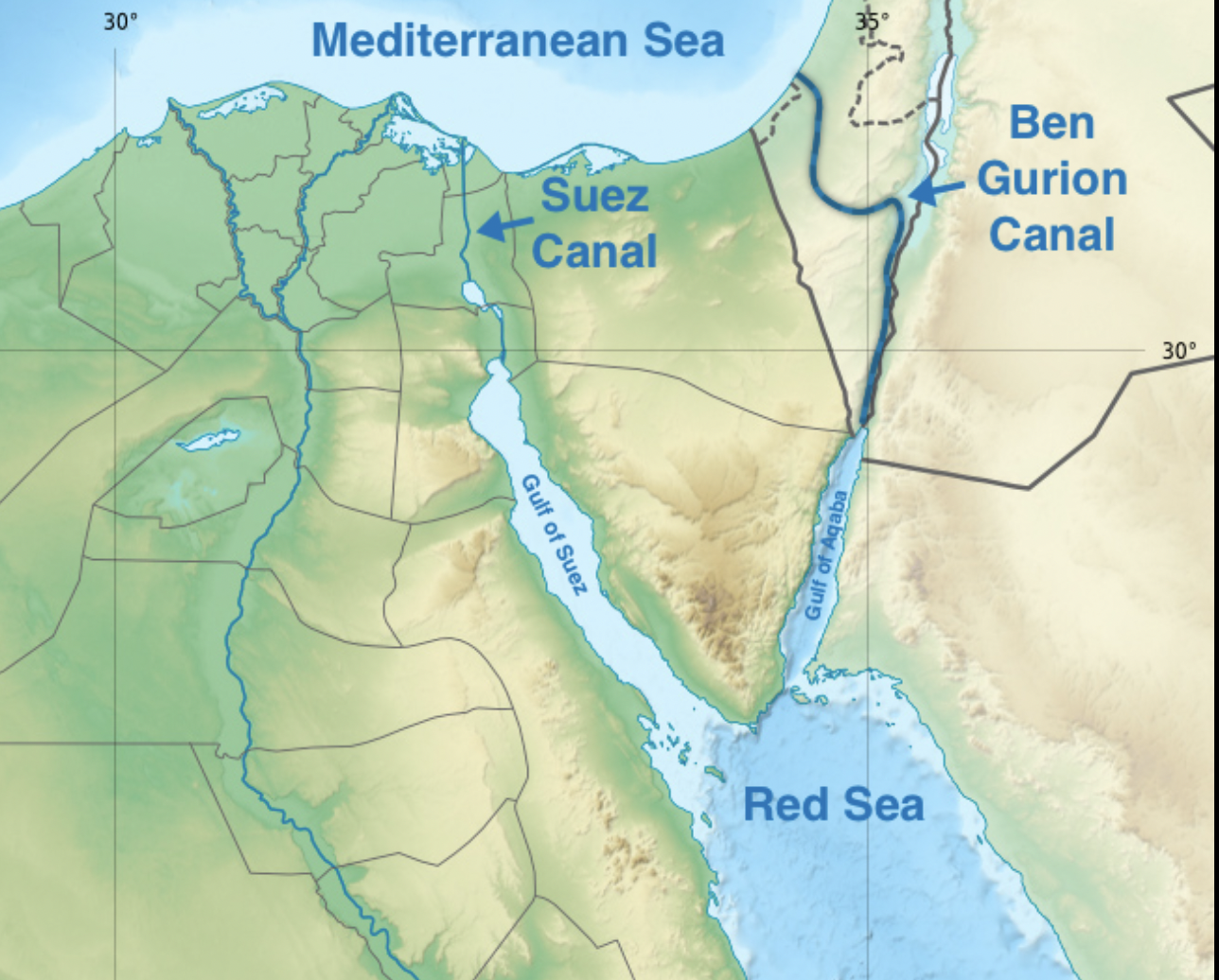
GlobalResearch: Video: Israel Destroys Gaza to Control World’s Most Important Shipping Lane? The Ben Gurion Canal Linking the Eastern Mediterranean to the Gulf of Aqaba
Incisive and carefully documented geopolitical analysis by Richard Medhurst pertaining to the building of the Ben Gurion Canal linking the Eastern Mediterranean to the Gulf of Aqaba.
The Ben Gurion Canal Project was initially a “secret” (classified) U.S. project formulated in 1963 by the Lawrence Livermore National Laboratory LLNG, a strategic think tank (focussing on nuclear radiation) on contract with the U.S Department of Energy. The LLNG project was formulated in response to the nationalization of the Suez Canal in July 1956 by President Gamal Abdel Nasser (1956-1970). Its intent was to bypass the Suez Canal.
According to the “classified” document prepared by the LLNG (1963) quoted by Business Insider, July 2023, a strategic plan was envisaged:
“to blast an alternative Suez Canal through Israel using 520 nuclear bombs”.
The plan consisted in using 520 buried nuclear explosions “to help in the excavation process through the hills in the Negev Desert. The document was declassified in 1993”. I have not been able to consult the “declassified” LLNG document.
The declassified document is acknowledged in Richard Medhurst’s video.
This U.S. plan, first negotiated with Israel in the 1960s is of utmost relevance to unfolding events in Palestine.
It’s objective is to achieve US-Israeli Maritime Dominance against the people of the Middle East. In the context of a broader US-led Middle East War, the Ben Gurion Canal Project is part of America’s hegemonic military agenda. It is consistent with Netanyahu’s “Plan to Wipe Palestine Off the Map”:
The Ben Gurion Canal will give Israel in particular and other friendly nations the freedom from blackmail arising out of access to the Suez Canal.
Arab states have been leveraging the Red Sea to pressure Israel and in response, Israel has decided to gain more control of the Red Sea. These African countries have cultural and economic affinities with the Arab states. One of the main military benefits for Israel is that it gives Israel the strategic options as the Ben Gurion Canal will totally take away the importance of Suez for the US military if needed in the aid for Israel.
Israel aims to push Egypt further into a corner by eliminating Suez in the global trade and energy corridor and becoming a global trade and energy logistics center.
Experts are of the opinion that this situation will shake the strategic-energy balance of China’s Belt and Road Project initiative in the Mediterranean, along with the Strait of Hormuz, which is the transfer point of 30 percent of the world’s energy. The Ben Gurion Canal would have the solid backing of the West. (Eurasia Review, November 7, 2023, emphasis added)
President Biden is broadly supportive of the Israeli led genocide. Visibly what is at stake is a U.S. hegemonic project which seeks the expulsion of Palestinians from their homeland and the appropriation of all Palestinian lands.
According to Yvonne Ridley:
👉“The only thing stopping the newly-revised [Ben Gurion Canal] project from being revived and rubber-stamped is the presence of the Palestinians in Gaza. As far as Netanyahu is concerned they are standing in the way of the project”👈 (Yvonne Ridley, November 10, 2023, emphasis added)….
Puts an interesting spin on the current Gaza war does it not? And then you can add in this:
Why Israel Created Hamas — Swiss Policy Research
Insider insights into the creation of Hamas – and other designated terrorist groups.
* * *
“Anyone who wants to thwart the establishment of a Palestinian state has to support bolstering Hamas and transferring money to Hamas.” – Benjamin Netanyahu (2019)
“In the visible dimension Hamas is an enemy, in the hidden dimension it is an ally.”
– IDF Major General Gershon Hacohen (2019)“Israel started Hamas. It was a project of Shin Bet.”
– Charles Freeman, US diplomat and ambassador (2006)* * *
A. Why Israel helped create Hamas
Since the founding of Hamas in 1987, Israeli, American and Palestinian officials have repeatedly acknowledged that Israel did indeed help create and fund the Islamist group.
The point made by many of these officials is not that Israel “allowed” the rise of Hamas or that Hamas emerged in response to Israeli “occupation” of Palestine. Rather, their point was and is that Israel’s intelligence agencies actively helped create and finance the Hamas group.
As the officials cited below make clear, the overall goal of supporting Hamas has been to thwart the creation of a Palestinian state and avert the implementation of a two-state solution to the Palestine question. From Israel’s perspective, a two-state solution would reduce Israel’s territory to the internationally recognized pre-1967 borders, prohibit any future territorial expansion, and prevent the recognition of Jerusalem as Israel’s capital city.
More specifically, supporting the Islamist Hamas group has served several Israeli objectives at once: first, it undermined Yasser Arafat’s secular nationalist PLO; second, it helped prevent the implementation of the 1993 Oslo Accords; third, it undermined the Palestinian National Authority and isolated Gaza from the Westbank; fourth, it impeded Western support for the Palestinian cause; and fifth, it justified Israeli (counter-)attacks on Palestinian territory…
Given the above and the desire for the new canal, this Jerusalem Post article makes sense.
With that as background, these articles by a French socialist clicks into place.
First, what does he mean by ‘Straussians’?
William Kristol, editor of The Weekly Standard is one of Leo Strauss’s acolytes. “…Strauss was a German Jewish émigré who arrived in the United States during the rise of fascism in Germany…. He instilled a cult-like devotion in his students—who became known as the Straussians…” LINK
The coup d’état of the Straussians in Israel
by Thierry Meyssan French journalist and political activist of the Left.
March 7 2023
While observers predicted a war of Israel against one of its neighbors, the Hebrew State is not attacked from anywhere. It has opponents, but no enemy, except itself. Its political organization is not defined by any constitution and is therefore easy to overthrow. The Straussians, who are in power in the State Department and the White House, are now driving the change of its regime. [He is talking about Biden -GC] Demonstrations are taking place throughout the country to prevent the country from becoming, in the words of a former Mossad director, “a racist and violent state that cannot survive. But it is probably already too late...
Most of the Federalist Society’s adherents are just conservative or libertarian lawyers. They were only concerned with family law and economic law. However, within the Society, a small group became involved in international politics. It is this group that influences Israel today. In the United States, it first succeeded in making “American exceptionalism” triumph . [4].
This school of thought refuses to apply international treaties in domestic law; judges the behaviour of others harshly, but absolves Americans who do the same on principle; and refuses to allow any international jurisdiction to take an interest in its internal affairs. In short, it believes that, for religious reasons, the United States is not comparable to other states and should not be subject to any international law…. (See TheseTruths comment from February 17, 2025)
The other major struggle of this Federalist Society group was to overturn the “non-delegation doctrine. American jurists believed that the separation of constitutional powers did not allow the executive to encroach on the privileges of the legislature and to define the criteria for the application of a law. Now, the opposite is true: the separation of powers prohibits the Legislative branch from interfering with the activities of the Executive branch. The Congress thus loses its power to control the White House. It is on the basis of this sleight of hand that President George W. Bush was able to launch a series of wars and to generalize torture.
The links between this Federalist Society group and the Israeli Likud are not new. In 2003, Elliott Abrams organized the Jerusalem Summit with the participation of almost all Israeli political groups. He said that there would be no peace in the world until Israel crushes the Palestinians’ demands…
Bezalel Smotrich sees the Arabs as wild animals that must be tamed by force. But the Minister of National Security, Itamar Ben-Gvir, approaches the issue from a different point of view. For him, God gave the land to the Jews who must expel the Arab squatters from it. Regardless of the points of view, all members of the coalition agree on one thing: the government is sovereign and should not be restricted by laws. This suits Prime Minister Benjamin Netanyahu, who is under judicial investigation.
👉What is going on in Israel is not just about Israelis and Palestinians. Elliott Abrams is a historic Straussian, even more so than the US Secretary of State, Antony Blinken, and his deputy, Victoria Nuland. It is therefore foreseeable that if the “reform” of the Israeli justice system continues, the new regime will be fully aligned with the positions of the Straussians.👈 For the time being, Israel refuses to send arms to Ukraine according to the principle of General Benny Gantz: “No Israeli arms should reach the mass murderers of Jews”. The risk of an alliance between Ukrainian “integral nationalists”, American “Straussians” and Israeli “revisionist Zionists” has never been greater [6]. The United States has just banned the Minister of Finance, Bezalel Smotrich, from visiting its territory. They still sanction his racist remarks, but for how long?
Do not forget that Kissinger was an agent of the Brits. LINK And the upsurge of Islamic orthodoxy-whether of the Iran variety, or that of the more commonly known Muslim Brotherhood, or the Jamaati Islam of Pakistan, or even the mystical Sufi brotherhoods of Asia-is a project of the City of London. After all war is so very, very profitable.
The second article by Thierry Meyssan.
September 12, 2024
The recent general strike in Israel is not just a demonstration against the rhetoric that we shouldn’t negotiate with terrorists and that the IDF will release the hostages held in Gaza. It marks the beginning of a realization that Prime Minister Benyamin Netanyahu is not defending Jews. While Jewish Israelis are not yet aware of the ethnic cleansing in Gaza, they are becoming aware of the anti-Arab pogroms in the West Bank. Gradually, they are beginning to admit that their enemies are not their neighbours, but are among them. These are the revisionist Zionists.
….As a result, the question we’ve been asking since mid-November[1]is also starting to resonate with Israelis:
👉 what if Benyamin Netanyahu wasn’t incompetent, but an accomplice in the attack?👈
I think we can make a very good guess as to the answer, Yes Netanyahu was fully on board with allowing the attack and the ‘Standown’ of Israel troops. Given 9/11 that should sound very familiar.
…..
Since a lot of this has to do with the Rothschilds, I want to also add para59r comments to the end of this article.
“…last Wednesday brought in some solid evidence that suggests the Rothschilds are SATANIC rather than benign.
https://twitter.com/para59r/status/1828443065595408669

“Oh and of course she didn’t mind people associating Baphomet with Satanism. The Rothchild’s loved that sort of thing.”




